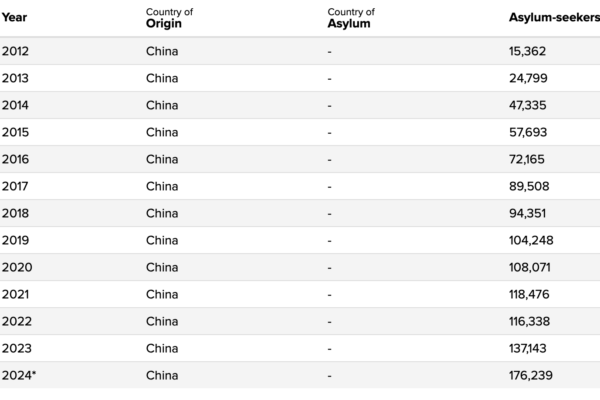International human rights organization Safeguard Defender recently released a report stating that according to data published by the United Nations Refugee Agency, the cumulative number of asylum seekers from China has surpassed one million since Xi Jinping took office.
The report published by Safeguard Defender on January 7th highlighted that over the past two years, numerous dramatic cases of individuals fleeing China have been reported by the media. The data released by the United Nations Refugee Agency confirms that this trend began almost immediately after Xi Jinping came to power.
The latest data from the United Nations Refugee Agency regarding the years 2022, 2023, and 2024 (with 2024 data based on predictions for the first half of the year) shows an increasing number of Chinese citizens seeking asylum abroad.
The Refugee Agency predicts that the number of Chinese asylum seekers in 2024 will reach 176,239, reaching a new historical high. The number of asylum seekers in 2024 increased by 169% compared to pre-pandemic levels in 2019 (104,259 people). The number of asylum seekers in 2024 has increased by 1,426% compared to when Xi Jinping took office in 2012 (12,362 people).
Since Xi Jinping took office in 2012, the cumulative number of asylum seekers from China has exceeded one million, reaching 1,158,739 people.
The report also points out that the number of asylum seekers has been growing at a record pace since Xi Jinping came to power. The number of asylum seekers in 2022 alone was equivalent to the total number during Hu Jintao’s ten-year term. The main destinations for asylum seekers are the United States, with over 80,000 Chinese citizens applying for asylum in 2021, followed by Australia, Canada, Brazil, South Korea, and the UK.
According to the United Nations definition, the people protected or assisted by the Refugee Agency include forcibly displaced persons (refugees, asylum seekers, others in need of international protection, and internally displaced persons); stateless persons (most of whom are not forcibly displaced persons); and other groups to whom the Refugee Agency provides protection or assistance based on humanitarian grounds.

